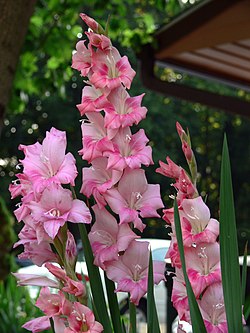Gladiolus
Gladiolus (from Latin, the diminutive of gladius, a sword) is a genus of flowering plants in the iris family (Iridaceae). Sometimes called the sword lily, the most widely-used English common name for these plants is simply gladiolus (plural gladioli, gladioluses or sometimes gladiolas).
| Gladiolus | |
|---|---|

| |
| Gladiolus | |
| Scientific classification | |
| Kingdom: | |
| Division: | |
| Class: | |
| Order: | |
| Family: | |
| Subfamily: | |
| Tribe: | |
| Genus: | Gladiolus |
Description
changeThe genus Gladiolus contains about 260 species, of which 250 are native to sub-Saharan Africa, mostly South Africa. About 10 species are native to Eurasia. There are 160 species of Gladiolus endemic in southern Africa and 76 in tropical Africa. The species vary from very small to the spectacular giant flower spikes in commerce.
These attractive, perennial herbs are semihardy in temperate climates. They grow from rounded, symmetrical corms, that are enveloped in several layers of brownish, fibrous tunics.
Their stems are generally unbranched, producing 1 to 9 narrow, sword-shaped, longitudinal grooved leaves, enclosed in a sheath. The lowest leaf is shortened to a cataphyll. The leaf blades can be plane or cruciform in cross section.
The fragrant flower spikes are large and one-sided, with secund, bisexual flowers, each subtended by 2 leathery, green bracts. The sepals and the petals are almost identical in appearance, and are termed tepals. They are united at their base into a tube-shaped structure. The dorsal tepal is the largest, arching over the three stamens. The outer three tepals are narrower. The perianth is funnel-shaped, with the stamens attached to its base. The style has three filiform, spoon-shaped branches, each expanding towards the apex.
The ovary is 3-locular with oblong or globose capsules, containing many, winged brown, longitudinally dehiscent seeds. In their center must be noticeable the specific pellet like structure which is the real seed without the fine coat. In some seeds this structure is wrinkled and with black color. These seeds are unable to germinate.
These flowers are variously colored, pink to reddish or light purple with white, contrasting markings, or white to cream or orange to red.
The South African species were originally pollinated by long-tongued anthrophorine bees, but some changes in the pollination system have occurred, allowing pollination by sunbirds, noctuid and sphingid moths, long-tongued flies and several others. In the temperate zones of Europe many of the hybrid large flowering sorts of gladiolas can be pollinated by small well-known wasps. Actually, They are not very good pollinators because of the large flowers of the plants and the small size of the wasps. Another insect in this zone which can try some of the nectar of the gladioli is the best-known European Hawk-moth Macroglossum stellatarum which usually pollinates many famous garden flowers like Petunia, Zinnia, Dianthus and others.
Gladioli are used as food plants by the larvae of some Lepidoptera species including the Large Yellow Underwing.